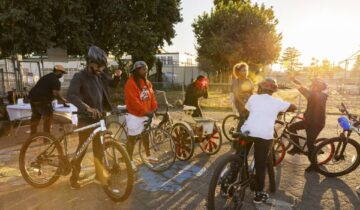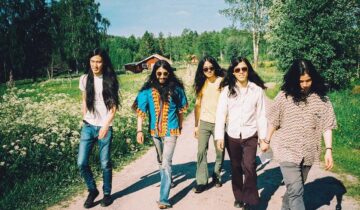 Skateboarding’s Latest Trick: Reviving Cities
Skateboarding’s Latest Trick: Reviving Cities
New skate plazas in cities from San Francisco to Paris are proving that making spaces skateable makes them safer and more dynamic.
By Gary Moskowitz for REASONS TO BE CHEERFUL, a solutions journalism site.
May 6, 2024
Rosa Chang and her husband and son live on the Manhattan side of the Brooklyn Bridge, in an extremely densely-populated urban area — roughly 47,000 people living within a half-mile radius — sandwiched between downtown Manhattan and the Lower East Side.
In 2020, when her son was four and the pandemic was in full swing, Chang grew frustrated that the urban design of their immediate neighborhood was dividing people, not bringing them together.
“There were all of these separating walls in our community,” Chang says. “There was not enough public space. Our children were playing between parked cars.”
She was well aware of a huge, nine-acre plot of land under the bridge that had been fenced off as a construction site and parking lot for more than 10 years, so she started raising the question at community meetings and around the neighborhood: What if we could use that space?
Chang reached out to two Pace University students who had started a Change.org petition to save the Brooklyn Banks. They introduced her to local skateboarder and skateboarding advocate Steve Rodriguez, who took her for a site walk and explained the space’s history. During the ’80s and ’90s, this plot of land had been home to the Brooklyn Banks, an iconic skate spot with rolling, banked surfaces and stairs. But over time, the area became associated with homelessness and drug use, and eventually found itself dormant behind those fences.
Chang and Rodriguez formed a nonprofit in 2021 called Gotham Park and spent the next two years pushing to get the space back for community use. Fast-forward to May 2023, as Chang watched city officials reopen the Brooklyn Banks, a refurbished skate plaza, and The Arches, a public space with basketball, pickleball courts and park benches.
“I was just naive enough to have the conviction that this must be done,” Chang says. “It took community advocates and skaters to make this happen. This project was so ripe with potential for economic revitalization for a long-ailing neighborhood.”
Older adults from the nearby Hamilton Madison House nonprofit now come to The Arches for intergenerational Zumba, Tai Chi and Qigong. There have been community potlucks and a block party, a Go Skate Day event last June, and volunteers have pulled weeds and planted new gardens, according to Gotham Park.
The Brooklyn Banks project is just one of several recent revitalization efforts in densely populated urban areas, including San Francisco and Paris, that have embraced skateboarding as an integral component of public spaces. Rather than chase skaters away, or put up metal “skate stoppers” and other hostile architecture on curbs and ledges, or issue them citations or arrest them — things that many skaters in the ’80s and ’90s likely experienced — community activists, organizers and city parks officials are doing the opposite: encouraging skateboarders to spend time in public plazas by designing them to be undeniably skateable.
Around the same time Chang was ramping up her efforts in NYC, a similar situation was unfolding around San Francisco’s U.N. Plaza, a large public space near the Civic Center BART stop, just steps from City Hall. Residents — and Mayor London Breed — had long been frustrated by the drug dealing, homelessness, public urination and selling of stolen goods that had plagued the plaza.
Like New York City, San Francisco has a long skateboarding history — thanks to epic hills and skateable street terrain — but the sport was not typically welcomed by authorities in public spaces. But now, the San Francisco Recreation and Parks Department was eager to clean up the area and bring it to life with games and sports.
Inspired by other public urban centers — in particular the Place de la République in Paris — that had intentionally added skateable features to plazas to encourage activity and positive community gatherings, Rec and Park officials decided to make skateboarding a key feature of the revitalized plaza. To do so, they teamed up with local skateboarding advocates from the San Francisco Skate Club, Thrasher Magazine, Deluxe Distribution and skate shop, and the Tony Hawk Foundation.
The skateboarding conversation was not new: City officials had previously blocked off Waller Street, a small side road on the edge of Golden Gate Park, and designated it as a place for kids to learn to ride bikes, but the idea never took off. Skateboarders organically took over the space and city officials eventually acquiesced, and donated benches and marble and granite boxes and objects left over from salvage yards, according to Ashley Rehfeld, a marketing director with skateboarding company Deluxe Distribution who was involved in planning the San Francisco skate plaza.
Rehfield, 34, has skated since she was 13. It was the “shared pulse of creativity” that hooked her, the way skating is individualized but also communal: Everyone has their own style and approach but they’re in it together. She and her friends would ride the bus to get to spots, so skateboarding was their portal into the city.
To Rehfeld, the Waller project showed proof of concept, convincing city officials that skateboarding could be beneficial. “We showed the city that we can do a lot with a little,” she says, reflecting on the U.N. Plaza project and other recent efforts. “It was kind of a hilarious evolution of a city seeing how skating can be part of a solution, not a problem, but we got there. If you want a vibrant city for all groups, you have to build it with key people, then people will come. The city trusted us.”
In December 2023, city officials unveiled a new 13,000-foot skate plaza, alongside exercise stations, ping pong and Teqball tables, and chess tables. The renovation cost $2 million. Since then, according to the San Francisco Police Department, daytime drug-related incidents at the plaza have dropped by 64 percent, compared to the same time period in 2022 to 2023. Rec and Park says average daily visitation has increased by roughly five percent — a number that’s expected to rise as the weather warms.
“We have skate parks, but they can feel grossly cluttered. The point is to be in a shared space, not tucked away in a dark corner behind an ugly fence,” says Ryen Motzek, president of the Mission Merchants District Association and a partner in San Francisco’s DLXSF skate shop. “The city needs actual skate spaces in public areas where people like to hang out. There’s a history of skating here. We wanted to honor that, and make it fun and accessible.”
In February, U.N. Plaza hosted skateboard lessons, a trick contest and an open skate session, and Rec and Park staff added cornhole boards and foosball tables this spring. An art installation by Charles Gadeken is now on display in the plaza, and free concerts take place every week at the adjacent Fulton Plaza, where a large koi mural by artist Jeremy Novy was recently installed.
The skate plaza at the Place de la République in Paris had similar DNA to the now-renovated squares in San Francisco and New York City: City leaders wanted to revitalize a public space with a fun atmosphere driven by physical activity.
In the 2010s, there was a strong sense that the Place de la République was being abandoned and that crime and homelessness were on the rise. In 2016, the area became a popular meeting point for a surge of labor-law protests, some of which had ended in violence, which scared away local residents, according to officials who were working to revitalize the area at that time.
Skate and surf apparel brand Volcom had just opened a store in the neighborhood and had recently collaborated with city officials on a temporary skateboarding activation at the Bastille plaza, so it agreed to get involved.
Architect Paolo Guidi collaborated with Volcom to design a permanent structure that looked as interesting as its surroundings. The plaza is a beautiful spot with historic architecture, so Guidi wanted to build something that looked like a sculpture rising up out of the ground. The project took a year to finish.
“We had to be respectful of the way people like to be on the plaza, to be able to be active but also sit, and also make the space inviting for girls and boys,” Guidi says. “If seven-year-old girls and 70-year-old women can feel good in a space, then it’s good. If mom and dad and the kids can come, then it is safe and it changes the way people think about it.”
Guidi is into surfing and judo, but grew up skateboarding. When he arrived in Paris at age 10, he got to know the city through skating. Today, his favorite movie is Dogtown and Z Boys, the 2001 documentary by skater Stacy Peralta. He sees himself as an athlete and an artist.
“Skateboarding always had a bad image, and politicians usually see skaters as invaders, but most are very respectful,” Guidi says.“We used skateboarding to show that you can think about public spaces differently. I wanted to show what’s underneath that. Skating is beautiful and pure.”
As many as 1,500 people have attended large events in the plaza that included free skateboarding competitions, skateboarding lessons, photography exhibitions, film screenings and live DJs. City officials say that within just a few weeks of the official opening, homeless tents were gone and families were coming to the plaza for exercise. Staff involved with the plaza revitalization have hosted “Do It Yourself” workshops that introduced participants to screen-printing on t-shirts, badges and hats, and Volcom hosted a “Give Back Series” program that collected jeans on site to donate to people in need.
Officials who collaborated on the skate plaza projects in New York, San Francisco and Paris all agreed that the X Games — action sports competitions that formed in 1995 — and the addition of skateboarding into the 2020 Summer Olympics in Tokyo did much to change the narrative about skateboarding from a dangerous outsider activity to an inclusive, mainstream sport.
Without that shift in perception, city officials would have been much less likely to approve these various skate plaza proposals, Rehfield says. When she and other skaters first began talking with city officials about the San Francisco skate plaza idea, they had no idea that people actually travel to San Francisco for skate tourism, since the city is one of the birthplaces of modern street skating. They now see the worth in that.
“You should not be arrested for skateboarding; it’s a portal for science and art and creativity, and for socializing and opening up the world around you,” Rehfield says. “It leads to incredible ways to figure out who you can become as a person. It’s not just a sport, it’s an enhancement of life. We’ve come a long way in just 40 years.”
Credits for scrolling images: Lanna Apisukh / The Skatepark Project, Rafael Ramirez Lee / Shutterstock, San Francisco Recreation and Parks, Volcom.



